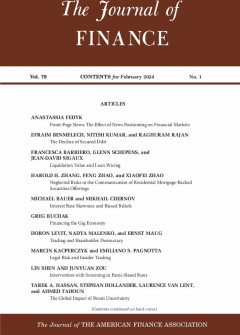Ditapis dengan

The Term Structure of Covered Interest Rate Parity Violations
We quantify the impact of risk-based and nonrisk-based intermediary constraints (IC) on the term structure of covered interest rate parity (CIP) violations. Using a stochastic discount factor (SDF) inferred from interest rate swaps, we value currency derivatives. The wedge between model-implied and observed derivative prices reflects the impact of nonrisk-based IC because our SDF incorporates r…
- Edisi
- Volume 79, Issue 3, June 2024, Pages 2077-2114
- ISBN/ISSN
- 1540-6261
- Deskripsi Fisik
- ill, chart, table, grafik, 678 hal, 20 cm
- Judul Seri
- -
- No. Panggil
- -

Interest Rate Skewness and Biased Beliefs
Conditional skewness of Treasury yields is an important indicator of the risks to the macroeconomic outlook. Positive skewness signals upside risk to interest rates during periods of accommodative monetary policy and an upward-sloping yield curve, and vice versa. Skewness has substantial predictive power for future bond excess returns, high-frequency interest rate changes around Federal Open Ma…
- Edisi
- Volume 79, Issue 1, February 2024, Pages 173-217
- ISBN/ISSN
- 1540-6261
- Deskripsi Fisik
- ill, chart, table, grafik, 788 hal, 20 cm
- Judul Seri
- -
- No. Panggil
- -

International Yield Curves and Currency Puzzles
The currency depreciation rate is often computed as the ratio of foreign to domestic pricing kernels. Using bond prices alone to estimate these kernels leads to currency puzzles: the inability of models to match violations of uncovered interest parity and the volatility of exchange rates. This happens because of the FX bond disconnect, the inability of bonds to span exchange rates. Incorporatin…
- Edisi
- Volume 78, Issue 1, February 2023, Pages 209-245
- ISBN/ISSN
- 1540-6261
- Deskripsi Fisik
- First Published: 16 November 2022
- Judul Seri
- -
- No. Panggil
- -

Pricing Currency Risks
The currency market features a small cross-section, and conditional expected returns can be characterized by few signals: interest differential, trend, and mean reversion. We exploit these properties to construct the ex ante mean-variance efficient portfolio of individual currencies. The portfolio is updated in real time and prices all prominent currency trading strategies, conditionally and un…
- Edisi
- Volume 78, Issue 2, April 2023, Pages 693-730
- ISBN/ISSN
- 1540-6261
- Deskripsi Fisik
- First Published: 16 November 2022
- Judul Seri
- -
- No. Panggil
- -
 Karya Umum
Karya Umum  Filsafat
Filsafat  Agama
Agama  Ilmu-ilmu Sosial
Ilmu-ilmu Sosial  Bahasa
Bahasa  Ilmu-ilmu Murni
Ilmu-ilmu Murni  Ilmu-ilmu Terapan
Ilmu-ilmu Terapan  Kesenian, Hiburan, dan Olahraga
Kesenian, Hiburan, dan Olahraga  Kesusastraan
Kesusastraan  Geografi dan Sejarah
Geografi dan Sejarah